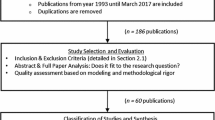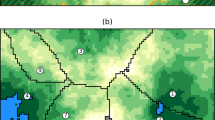Abstract
This paper discusses methods for directly incorporating spatial relationships in natural resource optimization models. The approaches are contrasted with the conventional emphasis on adjacency restrictions. Four formulations are presented that address a variety of problems using linear (continuous-variable) programming, which allows reliable solvability of even very large models. The problems addressed include: habitat placement for the black-footed ferret (an aggressive disperser), habitat placement for the black-tailed prairie dog (a gregarious, recalcitrant disperser), placement of control efforts directed at restricting the spread of an exotic pest, and the semi-permanent placement of habitat for the northern spotted owl (a static problem).
Similar content being viewed by others
References
L.J.S. Allen, Persistence and extinction in single-species reaction-diffusion models, Bulletin of Mathematical Biology 45 (1983) 209–227.
L.J.S. Allen, Persistence, extinction, and critical patch number for island populations, Journal of Mathematical Biology 24 (1987) 617–625.
J. Bart, Amount of suitable habitat and viability of northern spotted owls, Conservation Biology 9 (1995) 943–946.
P. Bettinger, K.N. Johnson and J. Sessions, Forest planning in an Oregon case study: defining the problem and attempting to meet goals with a spatial-analysis technique, Environmental Management 20 (1996) 565–577.
M. Bevers, J. Hof and C. Troendle, Spatially optimizing forest management schedules to meet stormflow constraints, Water Resources Bulletin 32 (1996) 1007–1015.
M. Bevers, J. Hof, D.W. Uresk and G.L. Schenbeck, Spatial optimization of prairie dog colonies for black-footed ferret recovery, Operations Research 45 (1997) 495–507.
M. Burgman, R. Church, I. Ferguson, R. Gijsbers, A. Lau, D. Lindenmayer, R. Loyn, M. McCarthy and W. Vandenberg, Wildlife planning using FORPLAN: A review and examples from Victorian forests, Australian Forestry 57 (1994) 1131–1140.
R.P. Cincotta, D.W. Uresk and R.M. Hansen, Demography of black-tailed prairie dog populations reoccupying sites treated with rodenticide, Great Basin Naturalist 47 (1987) 339–343.
R.P. Cincotta, D.W. Uresk and R.M. Hansen, A statistical model of expansion in a colony of blacktailed prairie dogs, in: 8th Great Plains Wildlife Damage Control Workshop Proceedings (USDA Forest Service GTR RM-154, 1988) pp. 30–33.
M.G. Garrett and W.L. Franklin, Prairie dog dispersal in Wind Cave National Park: Possiblities for control, in: Proceedings 5th Great Plains Wildlife Damage Control Workshop (University of Nebraska, 1981) pp. 185–198.
R.A. Haack and J.W. Byler, Insects and pathogens: regulators of forest ecosystems, Journal of Forestry 91 (1993) 32–37.
J. Hof, M. Bevers, L. Joyce and B. Kent, An integer programming approach for spatially and temporally optimizing wildlife populations, Forest Science 40 (1994) 177–191.
J. Hof, M. Bevers and J. Pickens, Chance-constrained optimization with spatially autocorrelated forest yields, Forest Science 42 (1996) 118–123.
J. Hof, M. Bevers and B. Kent, An optimization approach to area-based forest pest management over time and space, Forest Science 43 (1997) 121–128.
J. Hof, M. Bevers, D.W. Uresk and G.L. Schenbeck, Spatial optimization of habitat location for black-tailed prairie dogs in Southwestern South Dakota, in review.
J. Hof, Optimizing spatial and dynamic population-based control strategies for invading forest pests, Natural Resource Modeling 11 (1998) 197–216.
J. Hof and M.G. Raphael, Optimization of habitat placement: A case study of the northern spotted owl in the Olympic Peninsula, Ecological Applications 7 (1997) 1160–1169.
R.S. Holthausen, M.G. Raphael, K.S. McKelvey, E.D. Forsman, E.E. Starkey and D.E. Seaman, The contribution of federal and nonfederal habitat to persistence of the northern spotted owl on the Olympic Peninsula, Washington (Pacific Northwest Research Station, General Technical Report PNW-GTR-352, 1995).
J.L. Hoogland, The Black-Tailed Prairie Dog: Social Life of a Burrowing Mammal (University of Chicago Press, Chicago, 1995).
H. Kierstead and L. B. Slobodkin, The size of water masses containing plankton blooms, Journal of Marine Research 12 (1953) 141–147.
A.M. Liebhold, W.L. MacDonald, D. Bergdahl and V.C. Mastro, Invasion by exotic pests: A threat to forest ecosystems, Forest Science Monograph 30 (1995).
R.L. Linder, R.B. Dahlgren and C.N. Hillman, Black-footed ferret - prairie dog interrelationships, in: Symposium on Rare and Endangered Wildlife of the Southwestern United States (Albuquerque, NM, New Mexico Dept. of Game and Fish, 1972) pp. 22–37.
K. McKelvey, B.R. Noon and R.H. Lamberson, Conservation planning for species occupying fragmented landscapes: the case of the northern spotted owl, in: Biotic Interactions and Global Change, eds. P. Kareiva, J. Kingsolver and R. Huey (Sinauer Assoc., Sunderland, MA, 1992) pp. 424–450.
S. Minta and T.W. Clark, Habitat suitability analysis of potential translocation sites for blackfooted ferrets in north-central Montana, in: The Prairie Dog Ecosystem: Managing for Biological Diversity, eds. T.W. Clark, D. Hinckley and T. Rich (Montana Bureau of Land Management, Billings, 1989) pp. 29–46.
A. Okubo, Diffusion and Ecological Problems: Mathematical Models, Biomathematics 10 (Springer, Berlin, 1980).
J.G. Skellam, Random dispersal in theoretical populations, Biometrika 38 (1951) 196–218.
P.C. Van Deusen, Habitat and harvest scheduling using Bayesian statistical concepts, Canadian Journal of Forest Research 26 (1996) 1375–1383.
G.C. Varley, G.R. Gradwell and M.P. Hassell, Insect Population Ecology (Blackwell, Oxford, UK, 1973).
Author information
Authors and Affiliations
Rights and permissions
About this article
Cite this article
Hof, J., Bevers, M. Direct spatial optimization in natural resource management: Four linear programming examples. Annals of Operations Research 95, 67–81 (2000). https://doi.org/10.1023/A:1018902124311
Issue Date:
DOI: https://doi.org/10.1023/A:1018902124311




